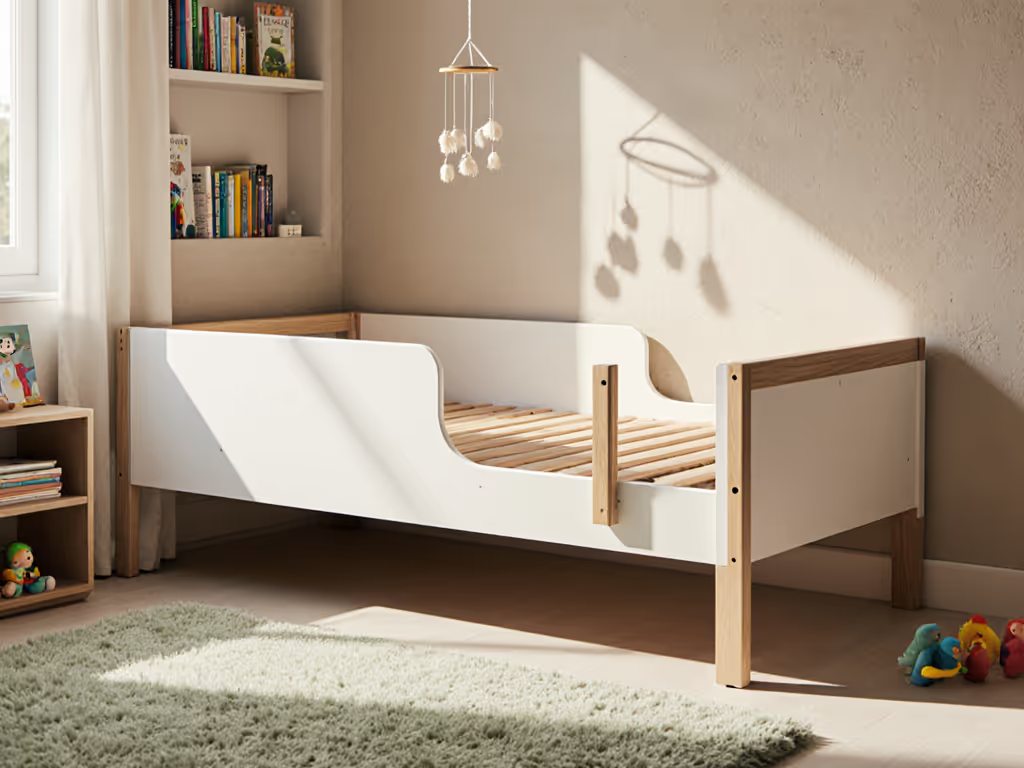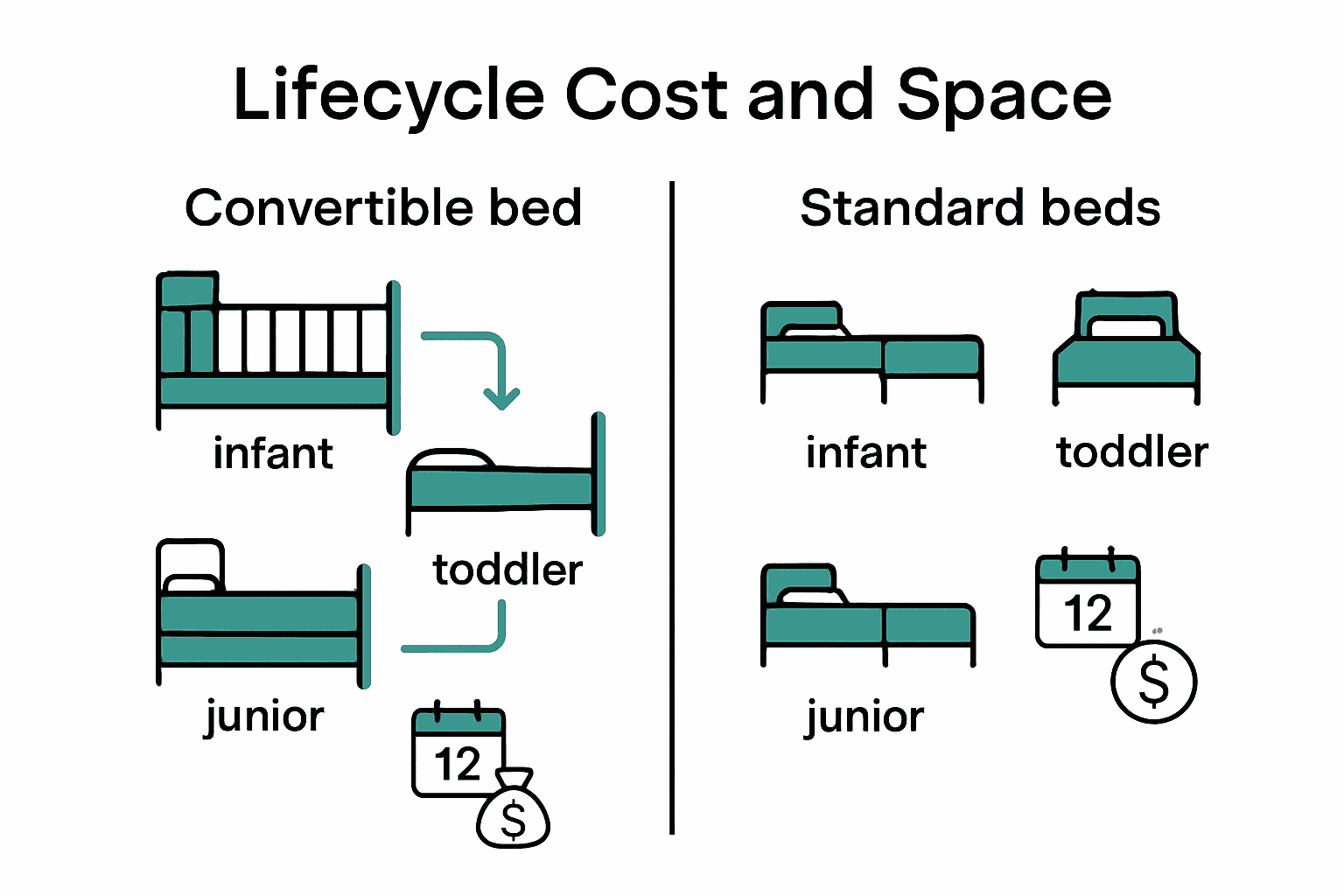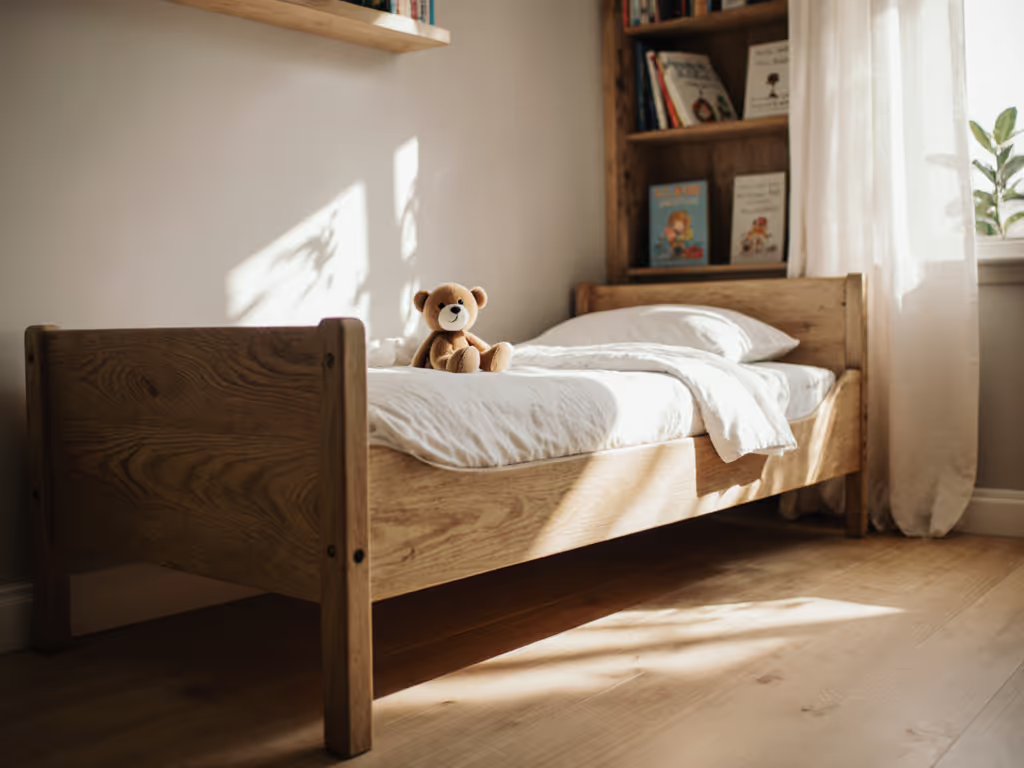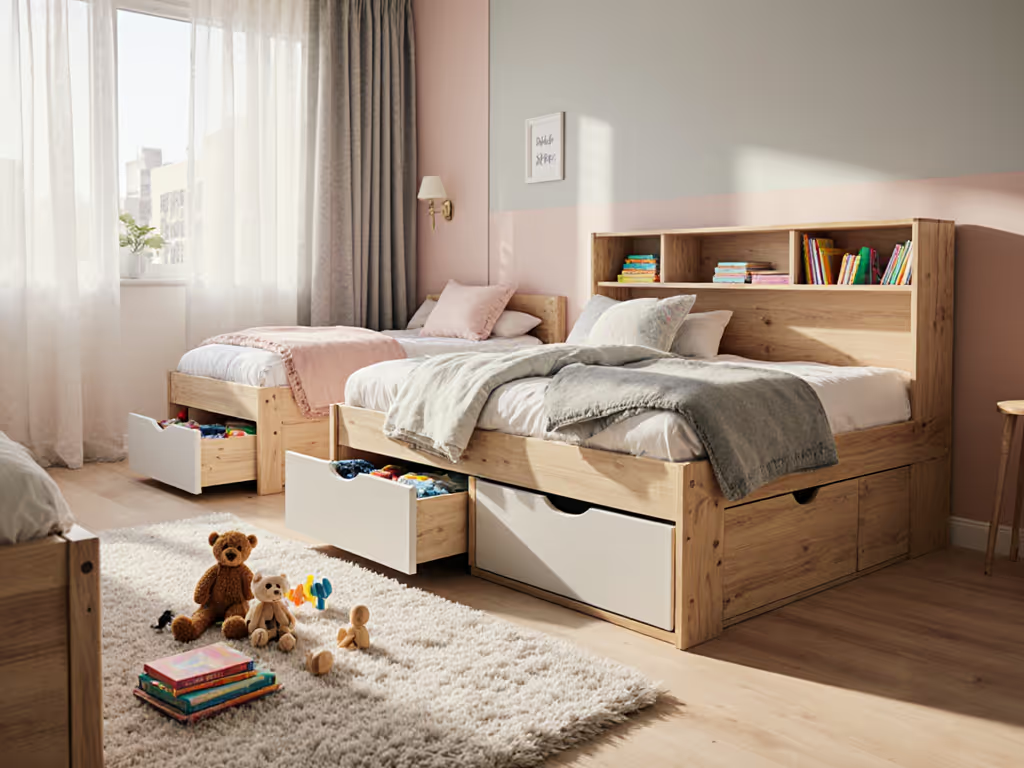
Convertible Beds Explained: Smart Solutions for Parents

Many parents are surprised to learn that over 60 percent of families switch their child's bed at least twice before age six. The constant buying and assembling can be exhausting, not to mention costly. Convertible beds for toddlers offer a smarter, long-term solution by adapting as your child grows. This guide will help you understand how these beds work, what types exist, and why they make sense for both your budget and your child’s safety.
Key Takeaways
| Point | Details |
|---|---|
| Convertible Beds Offer Value | They adapt from crib to toddler to junior beds, eliminating the need for multiple purchases over time. |
| Safety is Prioritized | Convertible beds incorporate features like adjustable rails and child-safe materials to ensure secure sleeping environments. |
| Space Efficiency | Suitable for small living spaces, convertible beds save room and reduce clutter caused by outgrown furniture. |
| Long-Term Investment | While initially higher in cost, their adaptability and longevity result in lower total ownership expenses compared to standard beds. |
What Are Convertible Beds for Toddlers?
Parents navigating the complex world of children's bedroom furniture often find themselves puzzled by the term convertible beds. These innovative sleep solutions represent more than just a piece of furniture they're a strategic investment in your child's sleep environment. A convertible bed is essentially a modular sleeping system designed to grow alongside your child, transforming from an infant crib to a toddler bed and sometimes even extending to junior bed configurations.
At its core, a convertible bed provides exceptional flexibility for parents seeking long-term value. Modular design allows these beds to adapt to your child's changing needs without requiring a complete furniture replacement. The conversion process typically involves removing crib side rails and replacing them with toddler-friendly guard rails, creating a lower, more accessible sleeping space that prevents accidental falls while giving young children a sense of independence.
The practical benefits of convertible beds extend far beyond simple adaptability. These beds offer significant financial advantages by eliminating the need to purchase multiple beds as your child grows. Most convertible beds are engineered to accommodate standard mattress sizes, which means you can use the same foundational mattress throughout different bed configurations. Key features often include:
- Adjustable rail heights for different developmental stages
- Sturdy construction using durable materials
- Smooth transition mechanisms between bed types
- Compatibility with standard mattress dimensions
Safety remains paramount in convertible bed design. Manufacturers carefully engineer these beds to meet rigorous child safety standards, ensuring that each configuration provides a secure sleeping environment. By investing in a convertible bed, parents can create a consistent, comfortable space that supports their child's growth from infancy through early childhood.
Types of Convertible Beds and Key Differences
Navigating the world of convertible beds reveals a fascinating array of designs that cater to different parenting styles and child development philosophies. While all convertible beds share the fundamental goal of adapting to a child's growth, they diverge significantly in their approach to design, functionality, and developmental support. Parents can choose from several distinct types, each offering unique advantages that address specific needs and living environments.

Three primary categories of convertible beds dominate the market: traditional rail-based beds, Montessori-inspired floor beds, and modular transformation beds. Traditional rail-based beds represent the most common design, featuring removable side rails that transition from a high-sided crib to a more open toddler bed configuration. These beds provide a sense of security and prevent accidental rolling, making them ideal for parents seeking a gradual transition for their young children.
Here's a comparison of the main types of convertible beds and their features:
| Bed Type | Design Features | Best For |
|---|---|---|
| Traditional Rail-Based | Removable rails<br>Height adjustments | Gradual crib-to-bed transitions |
| Montessori-Inspired Floor Bed | Floor-level frame<br>No side barriers | Child independence<br>Motor skills |
| Modular Transformation Bed | Expandable frame<br>Multi-configuration | Long-term use<br>Multiple setups |
Montessori-inspired floor beds represent a radical departure from conventional designs, emphasizing child independence and sensory exploration. These low-profile beds sit directly on the floor, allowing children to enter and exit independently, which supports motor skill development and autonomy. Unlike traditional beds, Montessori beds eliminate barriers, creating an open sleeping environment that encourages self-directed movement and learning.
The most advanced modular transformation beds offer unprecedented flexibility, capable of morphing through multiple configurations as children grow. Some innovative designs can transition from a basic toddler bed to low bunk configurations or even loft-style arrangements. Key characteristics of these beds include:
- Multiple height adjustment options
- Expandable frame dimensions
- Interchangeable component systems
- Compatibility with standard mattress sizes
- Robust construction supporting significant weight changes
Choosing the right convertible bed involves careful consideration of your child's developmental stage, room layout, and long-term family needs.
While each bed type offers distinct advantages, the ultimate goal remains consistent: creating a safe, comfortable, and adaptable sleeping environment that supports your child's growth and independence.
How Convertible Beds Support Safe Transitions
Transitioning a child from a crib to a toddler bed represents a pivotal moment in childhood development that can be fraught with potential safety challenges. Safety engineering in convertible beds addresses these critical concerns by incorporating thoughtful design features that minimize risks during this vulnerable developmental stage. The primary goal is creating a secure sleeping environment that adapts seamlessly to a child's growing independence and changing physical capabilities.
The most critical safety features of convertible beds focus on preventing accidental falls and providing appropriate boundaries for young children. Adjustable rail systems play a crucial role in this transition, allowing parents to gradually lower side rails and create a more open sleeping space that still provides protection. These engineered rail mechanisms typically include multiple height settings that correspond to different developmental stages, ensuring that the bed remains a safe haven as the child becomes more mobile and curious about exploring their surroundings.
Manufacturers of convertible beds adhere to stringent safety standards that go beyond basic design requirements. Key safety considerations include:
- Rounded edges to prevent potential injury
- Sturdy construction that can withstand active child movement
- Precise gap measurements to prevent entrapment
- Non-toxic materials resistant to wear and potential chewing
- Weight-tested frames that maintain structural integrity
Beyond physical design, convertible beds support safe transitions by addressing the psychological aspects of a child's sleep environment. The gradual adaptation from a confined crib to a more open bed helps children develop a sense of security while incrementally expanding their independence. Parents can further enhance safety by carefully preparing the surrounding bedroom environment, removing potential hazards and creating a controlled space that supports the child's newfound mobility and exploration.
Space Efficiency and Longevity Compared
In the realm of children's bedroom furniture, convertible beds emerge as champions of space efficiency and long-term value. These innovative sleeping solutions represent far more than a simple piece of furniture they are strategic investments that adapt to a family's evolving spatial and financial constraints. By designing beds that seamlessly transition through multiple developmental stages, manufacturers have created a solution that addresses the complex challenges of small living spaces and growing children.
The space optimization potential of convertible beds is particularly compelling for families living in compact urban environments or multi-generational households. Traditional bedroom furniture often requires multiple replacements as children grow, consuming valuable square footage and generating significant expense. Convertible beds eliminate this cycle by providing a single, adaptable piece that can transform from an infant crib to a toddler bed, and sometimes even to a junior or twin bed, without requiring a complete furniture overhaul.
Economic considerations play a crucial role in the long-term appeal of convertible beds. While the initial investment might seem higher compared to standard cribs, the total cost of ownership is dramatically reduced. Consider the financial implications:
- Eliminates need for multiple bed purchases
- Reduces furniture replacement costs
- Provides consistent sleeping environment
- Supports multiple children through different growth stages
- Minimizes storage and disposal expenses associated with outgrown furniture
Beyond financial and spatial advantages, convertible beds offer psychological benefits for both parents and children. The consistent sleeping environment creates a sense of familiarity and comfort, helping children feel secure during critical developmental transitions. By investing in a single, high-quality convertible bed, parents can create a stable, adaptable sleeping space that grows alongside their child, transforming from a protective infant sanctuary to an independent child's personal retreat.

Comparing Convertible Beds to Standard Options
When parents explore sleeping solutions for their growing children, the choice between convertible beds and standard options becomes a critical decision that impacts comfort, safety, and long-term value. Standard beds typically offer a more traditional approach, providing a fixed configuration designed for a specific age range, while convertible beds represent a dynamic, adaptive solution that evolves with the child's developmental stages.
Structural flexibility stands as the most significant distinguishing factor between these two bed types. Standard beds are essentially static furniture pieces, requiring complete replacement as a child outgrows their current sleeping arrangement. Convertible beds, by contrast, feature ingenious modular designs that allow seamless transitions between infant, toddler, and sometimes even junior bed configurations. This adaptability means parents can invest in a single piece of furniture that potentially serves their child for several years, dramatically reducing long-term furniture expenses.
The comparative advantages of convertible beds become even more pronounced when examining specific features:
- Adjustable rail heights for different developmental stages
- Ability to modify bed dimensions without purchasing new furniture
- Consistent sleeping environment throughout childhood
- Enhanced safety mechanisms during transition periods
- More cost-effective long-term investment
From a practical perspective, standard beds with fixed rails might initially seem more secure, offering a familiar and predictable sleeping space. However, convertible beds have evolved to incorporate sophisticated safety features that match and often exceed traditional bed designs. The key is finding a balance between providing a sense of security and supporting a child's growing independence, a nuanced approach that convertible beds are uniquely positioned to deliver.
Discover the Best Convertible Bed Solutions for Your Toddler
Transitioning your child safely from crib to toddler bed can feel overwhelming. The challenge of finding a secure, adaptable bed that grows with your little one while optimizing limited space is real. You want a bed that supports your child's independence but still offers the protection and comfort they need. Terms like "modular design," "adjustable rails," and "Montessori-inspired floor beds" are key to understanding your options and making the right choice.
At CityToddlerBeds.store, we specialize in guiding first-time parents through this decision. Our detailed articles cover everything from safety standards to space-efficient designs—all aimed at helping you create a cozy and long-lasting sleep environment. Don't wait until your child is ready to transition to start exploring the smartest bed solutions. Visit our main landing page today, and empower yourself with expert advice to find the perfect convertible bed that grows alongside your toddler. Your child's comfort and safety deserve an informed start—take that step now!
Frequently Asked Questions
What are convertible beds for toddlers?
Convertible beds are modular sleeping systems that grow with your child, transitioning from an infant crib to a toddler bed and sometimes to a junior bed, providing long-term value and adaptability.
How do convertible beds support safe transitions from cribs to toddler beds?
Convertible beds feature adjustable rail systems that allow parents to gradually lower side rails, creating a safe sleeping environment that adapts to a child's growing independence and physical capabilities.
What are the key differences between traditional rail-based convertible beds and Montessori-inspired floor beds?
Traditional rail-based convertible beds have removable rails for security, making them great for gradual transitions. Montessori-inspired floor beds encourage child independence by being low to the ground and eliminating barriers, allowing easy entry and exit.
Why are convertible beds a cost-effective choice compared to standard options?
Convertible beds eliminate the need for multiple bed purchases as your child grows, offering long-term financial savings by providing a versatile solution that can adapt through different stages of childhood.




